draw 3d pictures showing the bonding in the following
Structure of Organic Molecules
- Page ID
- 844
Here you volition acquire how to understand, write, describe, and talk-the-talk of organic molecules. Why were dissimilar cartoon techniques developed? Organic molecules can become complicated and big. It is a tiresome to have to constantly depict out every detail, peculiarly when non necessary, and so the o-chemist of the by developed these techniques to make it more convenient and easy. In add-on, some of these autograph ways of cartoon molecules give u.s. insight into the bail angles, relative positions of atoms in the molecule, and some eliminate the numerous hydrogens that can go in the way of looking at the backbone of the structure.
Introduction
Observe the following drawings of the structure of Retinol, the most common grade of vitamin A. The first drawing follows the straight-line (a.one thousand.a. Kekul é ) structure which is helpful when you want to expect at every single cantlet; nonetheless, showing all of the hydrogen atoms makes it difficult to compare the overall structure with other similar molecules and makes information technology difficult to focus in on the double bonds and OH grouping.

Retinol: Kekul é straight-line drawing
The post-obit is a bail-line (a.k.a. zig-zag) formula for retinol. With this simiplified representation, one tin can easily see the carbon-carbon bonds, double bonds, OH group, and CH3 groups sticking off of the the principal ring and chain. Also, it is much quicker to describe this than the i higher up. You volition larn to appreciate this type of formula writing after drawing a endless number of organic molecules.
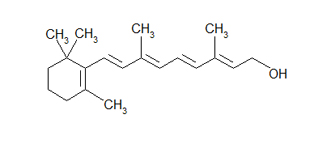
Retinol: Bond-line or zig-zag formula
Importance of Construction
Learning and practicing the basics of Organic Chemistry will help you immensely in the long run as you learn new concepts and reactions. Some people say that Organic Chemistry is similar another language, and in some aspects, information technology is. At offset it may seem difficult or overwhelming, but the more than you practice looking at and drawing organic molecules, the more familiar you will become with the structures and formulas. Another proficient idea is to go a model kit and physically make the molecules that you lot have trouble picturing in your head.
Through full general chemistry, you may have already experienced looking at molecular structure. The different ways to draw organic molecules include Keku fifty é (straight-line), Condensed Formul as, and Bond-Line Formulas (zig-zag). It will exist more than helpful if you become comfortable going from 1 mode of drawing to another, and look at drawings and understanding what they mean, than knowing which kind of cartoon is named what.
An case of a drawing that incorporates all iii ways to draw organic molecules would exist the following additional cartoon of Retin ol. The majority of the drawing is Bond-line (zig-zag) formula, but the -CH3 are written as condensed formulas, and the -OH group is written in Kekul é form.

A widely used style of showing the 3D construction of molecules is the use of dashes, wedges, and directly lines. This drawing method is essential considering the placement of different atoms could yield unlike molecules even if the molecular formulas were exactly the same. Below are two drawings of a 4-carbon molecule with 2 chlorines and ii bromines attached.


4-carbon molecule with 2 chlorines and 2 bromines iv-carbon molecule with 2 chlorines and 2 bromines
Both drawings look like they represent the same molecule; nevertheless, if we add together dashes and wedged we will see that two different molecules could be depicted:

The two molecules to a higher place are different, prove this to yourself by edifice a model. An easier style to compare the two molecules is to rotate i of the bonds (here, it is the bond on the right):
.jpg?revision=1&size=bestfit&width=246&height=74)
Find how the molecule on the correct has both bromines on the same side and chlorines on the same side, whereas the kickoff molecule is dissimilar. Read about Dashed-Wedged Line structures, lesser of page, to empathise what has been introduced above. You will learn more near the importance of atomic connectivity in molecules as you lot continue on to learn well-nigh Stereochemistry.
Drawing the Structure of Organic Molecules
Although larger molecules may look complicated, they can exist hands understood past breaking them down and looking at their smaller components.
All atoms want to have their valence shell total, a "closed shell." Hydrogen wants to have 2 e- whereas carbon, oxygen, and nitrogen want to have 8 due east-. When looking at the different representations of molecules, keep in mind the Octet Rule. As well remember that hydrogen can bond one time, oxygen tin bond up to two times, nitrogen can bond upwardly to three times, and carbon tin can bond up to four times.
.jpg?revision=1&size=bestfit&width=720&height=104)
Kekulé (a.k.a. Directly-Line Structures)
Kekul é structures are like to Lewis Structures, but instead of covalent bonds being represented by electron dots, the ii shared electrons are shown by a line.
(A) 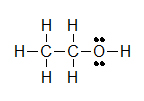 (B)
(B)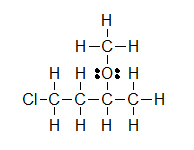 (C)
(C)
Lone pairs remain as two electron dots, or are sometimes left out even though they are however there. Discover how the three lone pairs of electrons were not depict in effectually chlorine in example B.
Condensed Formulas
A condensed formula is made up of the elemental symbols. The society of the atoms suggests the connectivity. Condensed formulas can exist read from either direction and HthreeC is the aforementioned as CHthree, although the latter is more than common because Look at the examples below and match them with their identical molecule under Kekul é structures and bond-line formulas.
(A) CHthreeCH2OH (B) ClCHiiCH2CH(OCHiii)CH3 (C) H3CNHCHiiCOOH
Let's look closely at instance B. As you go through a condensed formula, you want to focus on the carbons and other elements that aren't hydrogen. The hydrogen'due south are important, merely are usually in that location to consummate octets. Also, discover the -OCH3 is in written in parentheses which tell you that it not role of the main concatenation of carbons. As you read through a a condensed formula, if you reach an atom that doesn't have a complete octet by the time you lot reach the next hydrogen, and then it's possible that there are double or triple bonds. In example C, the carbon is double bonded to oxygen and single bonded to some other oxygen. Find how COOH means C(=O)-O-H instead of CH3-C-O-O-H considering carbon does not have a complete octet and oxygens.
Bail-Line (a.k.a. zig-zag) Formulas
The name gives away how this formula works. This formula is full of bonds and lines, and considering of the typical (more stable) bonds that atoms tend to make in molecules, they oft end up looking like zig-zag lines. If you work with a molecular model kit yous will find it hard to brand stick straight molecules (unless they incorporate sp triple bonds) whereas zig-zag molecules and bonds are much more feasible.
(A)  (B)
(B)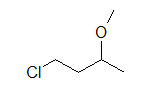 (C)
(C)
These molecules stand for to the exact same molecules depicted for Kekul é structures and condensed formulas. Notice how the carbons are no longer drawn in and are replaced by the ends and bends of a lines. In addition, the hydrogens have been omitted, only could be easily drawn in (see practise problems). Although we do not usually depict in the H's that are bonded to carbon, we exercise draw them in if they are connected to other atoms besides carbon (example is the OH group above in instance A) . This is done because information technology is not e'er articulate if the not-carbon cantlet is surrounded by alone pairs or hydrogens. Also in example A, notice how the OH is fatigued with a bond to the second carbon, just it does non mean that there is a 3rd carbon at the end of that bond/ line.
Dashed-Wedged Line Construction
As you may have guessed, the Dashed-Wedged Line structure is all about lines, dashes, and wedges. At first it may seem confusing, but with exercise, understanding dash-wedged line structures will get like second nature. The post-obit are examples of each, and how they can be used together.
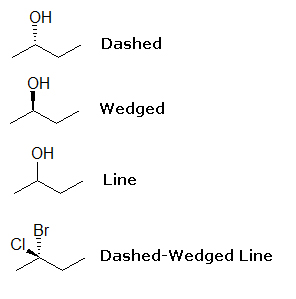
Above are four-carbon chains with fastened OH groups or Cl and Br atoms. Remember that each line represents a bond and that the carbons and hydrogens have been omitted. When you expect at or draw these structures, the straight lines illustrate atoms and bonds that are in the same aeroplane, the plane of the paper (in this case, figurer screen). Dashed lines show atoms and bonds that go into the folio, behind the plane, away from you lot. In the above example, the OH grouping is going into the airplane, while at the same time a hydrogen comes out (wedged).

Bluish dewdrop= OH group; White dewdrop=H
Wedged lines illustrate bonds and atoms that come out of the page, in front of the plane, toward yous. In the 2d diagram above, the OH group is coming out of the plane of the paper, while a hydrogen goes in (dashed).

Blueish dewdrop= OH group; White bead=H
As stated before, straight lines illustrate atoms and bonds that are in the same plane every bit the paper, but in the 2D example, the straight line bail for OH means that information technology it unsure or irrelevant whether OH is going away or toward y'all. It is also causeless that hydrogen is also connected to the same carbon that OH is on.

Bluish bead= OH group; H is not shown
Try using your model kit to see that the OH group cannot prevarication in the same airplane at the carbon concatenation (don't forget your hydrogens!). In the final 2Dexample, both dashed and wedged lines are used because the attached atoms are not hydrogens (although dashed and wedged lines can be used for hydrogens).The chlorine is coming out the page while bromine is going into the page.

Blueish bead=Cl; Blood-red bead=Br
References
- Vollhardt, K. Peter C., and Neil Due east. Schore. Organic Chemistry: Construction and Office. 5th ed. New York: Westward. H. Freeman Visitor, 2007. 38-40.
- Klein, David R. Organic Chemical science I Every bit a Second Language. 2nd ed. Hoboken, NJ: John Wiley & Sons, Inc, 2007. 1-14.
Contributors
- Choo, Ezen (2009, UCD '11)
Source: https://chem.libretexts.org/Bookshelves/Organic_Chemistry/Supplemental_Modules_%28Organic_Chemistry%29/Fundamentals/Structure_of_Organic_Molecules
0 Response to "draw 3d pictures showing the bonding in the following"
Post a Comment